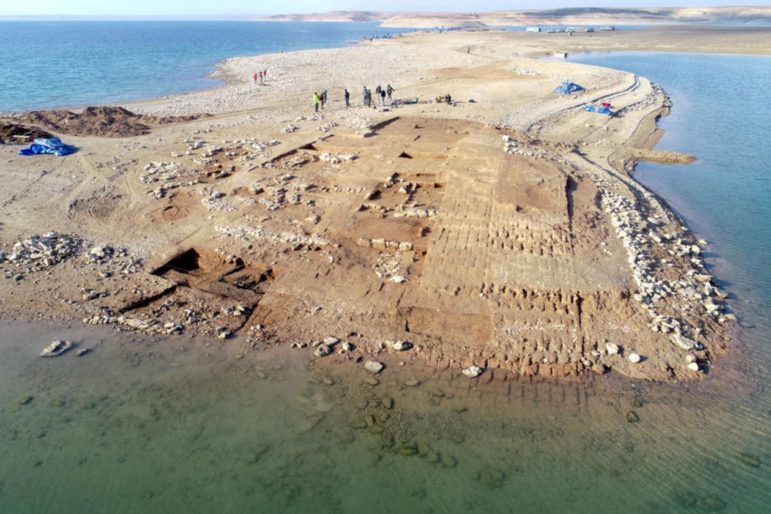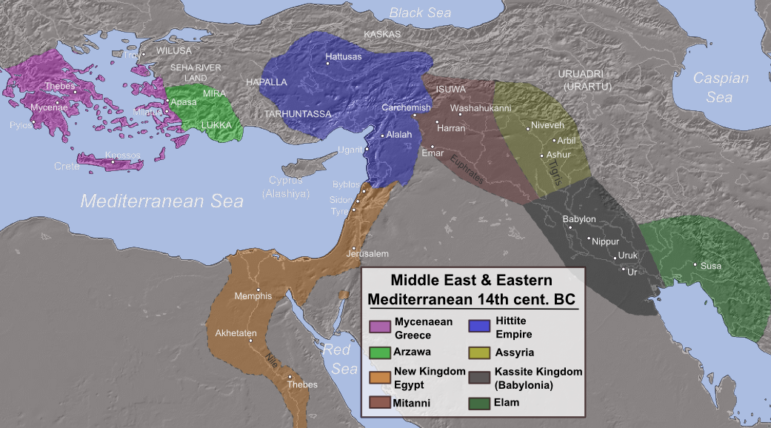TWH – Extreme weather sometimes reveals unknown or unexplored archaeological sites. A prolonged drought in Iraq has threatened its harvest and resulted in authorities releasing water from the Mosul reservoir for crop irrigation.
As the waters receded, the ruins of a Bronze Age, Mitanni city emerged. Archaeologists excavated the site and found “defensive walls, towers, a multi-story warehouse and more than 100 cuneiform boards.”

Aerial view of the excavations at Kemune with Bronze Age architecture partly submerged in the lake – Image credit: Universities of Freiburg and Tübingen, Kurdistan Archaeology Organization
Archaeologists have dated the ruins to around 1400 B.C.E. The ruins are those of Zakhiku, a city in the Mitanni Empire. That empire controlled parts of northern Syria and Mesopotamia from 1550 to 1350 B.C.E.
The 2018 excavation
In 2018, when an earlier drought had lowered the water height in the reservoir, the palace of Zakhiku emerged. Archaeologists seized the opportunity to examine its ruins.
In 2019, The University of Tübingen reported that this palace had walls up to seven meters tall (22.9 feet). They partially excavated eight rooms of the palace. Its inner, plastered walls had heights and thicknesses of up to two meters (6.6 feet). Vivid reds and blue murals covered those walls. Archaeologists think that such murals would have been common. Few Mitanni buildings, however, have survived.
Only three other Mitanni palaces have ever been found, but they were all from the outskirts of the empire. In contrast, Zakhiku lies close to the Mitanni heartland.
They also found ten cuneiform tablets. One of these tablets identified the site as the ancient city of Zakhiku. Other Mitanni records from 1800 B.C.E. refer to Zahiku. As these ruins date to roughly 1400 B.C.E, Zakhiku lasted for, at least, four-hundred years.
The palace had stood on an elevated platform, 20 meters (65.6 feet) from the east bank of the Tigris. The city lay to the palace’s north.
The 2022 excavation
In 2021, the waters of the reservoir had receded enough to expose the ruins of Zakhiku. Archaeologists knew that the water levels in the reservoir would begin to rise soon. They decided to excavate the ruins while they were above water. Kurdish archaeologist, Dr. Hasan Ahmed Qasim, joined two German archaeologists, Professor Dr. Ivana Puljiz of the University of Freiburg, and Professor Dr. Peter Pfälzner of the University of Tübingen. Oasim chairs the Kurdistan Archaeology Organization.
In their excavations, they found a massive fortification with walls and towers, as well as a multi-story warehouse, and a complex of workshops.
In 2022, the University of Tübingen reported on the significance of that warehouse. The size of the warehouse indicated that it stored a large number of goods. For Qasim, this capacity showed that “the site was an important center in the Mitanni Empire.”
Inside the warehouse, excavators found five ceramic jars containing more than 100 cuneiform tablets. These tablets do not date from the Mitanni period. They date from the latter Middle Assyrian period from 1350 to 1100 B.C.E.

View into one of the pottery vessels with cuneiform tablets, including one tablet which is still in its original clay envelope – Image credit: Universities of Freiburg and Tübingen, Kurdistan Archaeology Organization
The Mitanni Empire collapsed around 1350 B.C.E., and Zakhiku fell under Assyrian control. The cuneiform tablets may contain information about that transition.
A strong earthquake struck the region around 1350 B.C.E. which destroyed the city. The upper walls of buildings collapsed and buried the lower parts of the building which may have helped to preserve the structures.
Dried bricks formed the main building material in Zakhiku. The lack of water damage stunned the research team.
After excavation, archaeologists covered most of the site in tight-fitting plastic. Then they covered the buildings with gravel. The Mosul reservoir has returned to capacity. Now, water covers Zakhiku once more, at least until the next drought strikes.
The Mitanni Empire and its people
The Mitanni Empire extended from the eastern Mediterranean to northern Iraq. Its center lay in northeastern Syria.
Egyptian texts record that Mitanni had a similar status to that of Babylon, Egypt, and the Hittites. Mitanni rulers intermarried with Egyptian pharaohs.
The Smithsonian Magazine reported that the Mitanni produced the world’s oldest horse training manual. Masters of horsemanship, the Mitanni developed improved wheel technology for their war chariots.
Of all the kingdoms of the Bronze Age in Anatolia, Mesopotamia, and the Levant, the Mitanni Empire remains one of the least known. Very few of their records have survived and their religion left few remains. Surviving mentions of the Mitanni Empire mainly occur in treaties with Egypt, the Hittite Empire, or Assyria. Their Empire combined elements of the indigenous Hurrian culture with migrating or invading Indo-Aryan culture.

Map of Eastern Mediterranean and Middle East in 14th century – Image credit: Alexikoua, – CC BY-SA 3.0
Indo-Aryan refers to a branch of the Indo-European languages. That branch spread from the steppe region of Eurasia into south and western Asia. Another branch of that language spread into Europe.
Humans being human, people mix genetics and cultures. Languages can spread from one population to another, without one genetic population replacing another. Indo-European is a linguistic, not a genetic concept.
The link to the RigVeda
In their paper, “About the Mitanni-Aryan Gods,” Arnaud Fournet argued that Indo-Aryan words appear in surviving Mitanni texts. Those tablets include what may be the world’s oldest horse training manuals. Two surviving Hittite-Mitanni treaties mention major gods of the RigVeda, and specifically name Mitra, Varuna, Indra, and the Nasatya.
Other words in other surviving texts appear to be Hurrian. That language has no relation to any Indo-European or Semitic languages.
The Hurrian Storm-God
In “The Storm-Gods of the Ancient Near East: Summary, Synthesis, Recent Studies,” Daniel Schwemer argues for the prominence of storm gods in Upper Mesopotamia. Among the Hurrians, the major storm god had the name, Teššub. [Variations on spellings include: Teshub which is also written as Teshup, Teššup, or Tešup] Schwemer called Teššub, the “head of the Hurrian pantheon,” a divine king.

Chamber A, main scene depicting (left to right) the God Kumarbi (chief god of the Hurrians), the weather and storm god Teshuba, the earth goddess Hepat, Sharumma (son of Teshuba & Hepat) and Alanzu (daughter of Teshup Hepat), Yazılıkay in Hittite capital city of Hattusa, – Image credit: Carole Raddato, FRANKFURT, Germany – CC BY-SA 2.0
The main, barely-surviving Hurrian myth involves generational conflict. It only survives in fragments, mostly written in Hittite. The sky god, Anu, deposes his father, the primeval god, Alahu.
Kumarbi, of the same generation as Anu, then fights Anu and overthrows him. In that fight, Kumarbi bites off (and maybe eats) Anu’s genitals. That act of castration and absorption brings the divine line into the usurper, Kumarbi.
Anu, apparently still male, gives birth to a new generation of gods, including Tessub. His children, including Tessub, defeat Anu. Tessub becomes the new King of the Gods. Kumarbi returns and makes an alliance with the sea and underworld gods. Tessub eventually defeats that alliance.
This mythic complex has obvious parallels with the Uranus-Cronus-Zeus cycle. Modern Pagans may choose to view this myth cycle through a “genderqueer” lens. Scholars have studied its fragmentary sources, however, through a reconstructed language. A certain humility is in order. Some things are forever lost in the past, and we may never know.
The Wild Hunt is not responsible for links to external content.
To join a conversation on this post:
Visit our The Wild Hunt subreddit! Point your favorite browser to https://www.reddit.com/r/The_Wild_Hunt_News/, then click “JOIN”. Make sure to click the bell, too, to be notified of new articles posted to our subreddit.